FINANCE 5: Analysis of Toyota's Cash Conversion Cycle Report
VerifiedAdded on 2022/10/18
|7
|1230
|25
Report
AI Summary
This report provides a comprehensive analysis of Toyota's cash conversion cycle (CCC). It begins by defining the importance and purpose of the CCC, which measures the time it takes for a company to convert its investments in inventory into cash. The report then details the three key components of the CCC: Days Inventory Outstanding (DIO), Days Sales Outstanding (DSO), and Days Payable Outstanding (DPO). Using data from Toyota NZ (2019), the report calculates and analyzes Toyota's CCC, revealing that the company takes approximately 88.51 days to convert its working capital into cash. Several strategies are suggested to improve Toyota's CCC, including reducing inventory holding time, accelerating receivables collection, and optimizing payment terms with creditors. The report also emphasizes the significance of cash flow projections for new products, highlighting their role in assessing financial viability and ensuring adequate funds for covering costs. References from academic sources support the analysis.

FINANCE
Finance
Name of the student
Name of the university
Student ID
Author note
Finance
Name of the student
Name of the university
Student ID
Author note
Paraphrase This Document
Need a fresh take? Get an instant paraphrase of this document with our AI Paraphraser
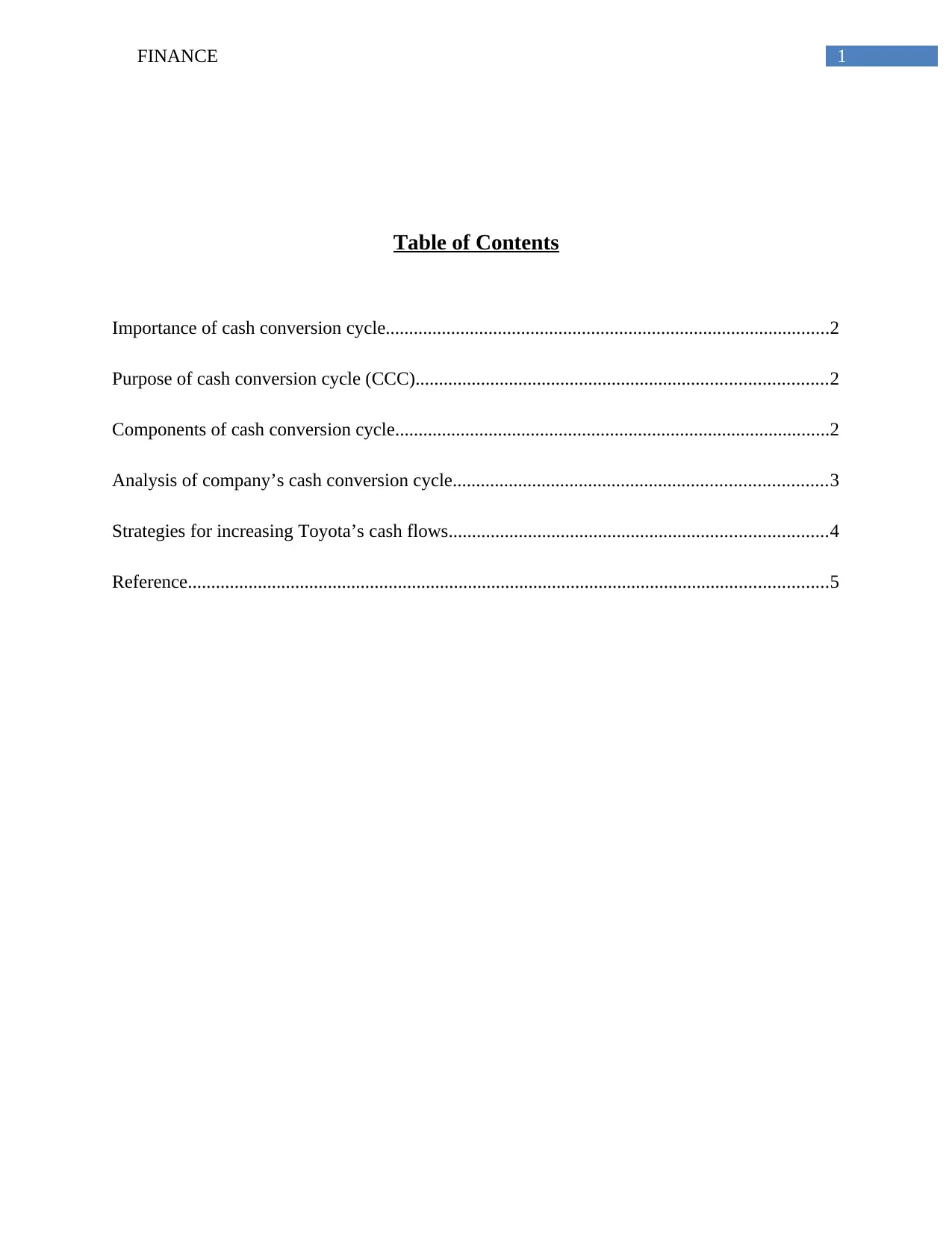
1FINANCE
Table of Contents
Importance of cash conversion cycle...............................................................................................2
Purpose of cash conversion cycle (CCC)........................................................................................2
Components of cash conversion cycle.............................................................................................2
Analysis of company’s cash conversion cycle................................................................................3
Strategies for increasing Toyota’s cash flows.................................................................................4
Reference.........................................................................................................................................5
Table of Contents
Importance of cash conversion cycle...............................................................................................2
Purpose of cash conversion cycle (CCC)........................................................................................2
Components of cash conversion cycle.............................................................................................2
Analysis of company’s cash conversion cycle................................................................................3
Strategies for increasing Toyota’s cash flows.................................................................................4
Reference.........................................................................................................................................5
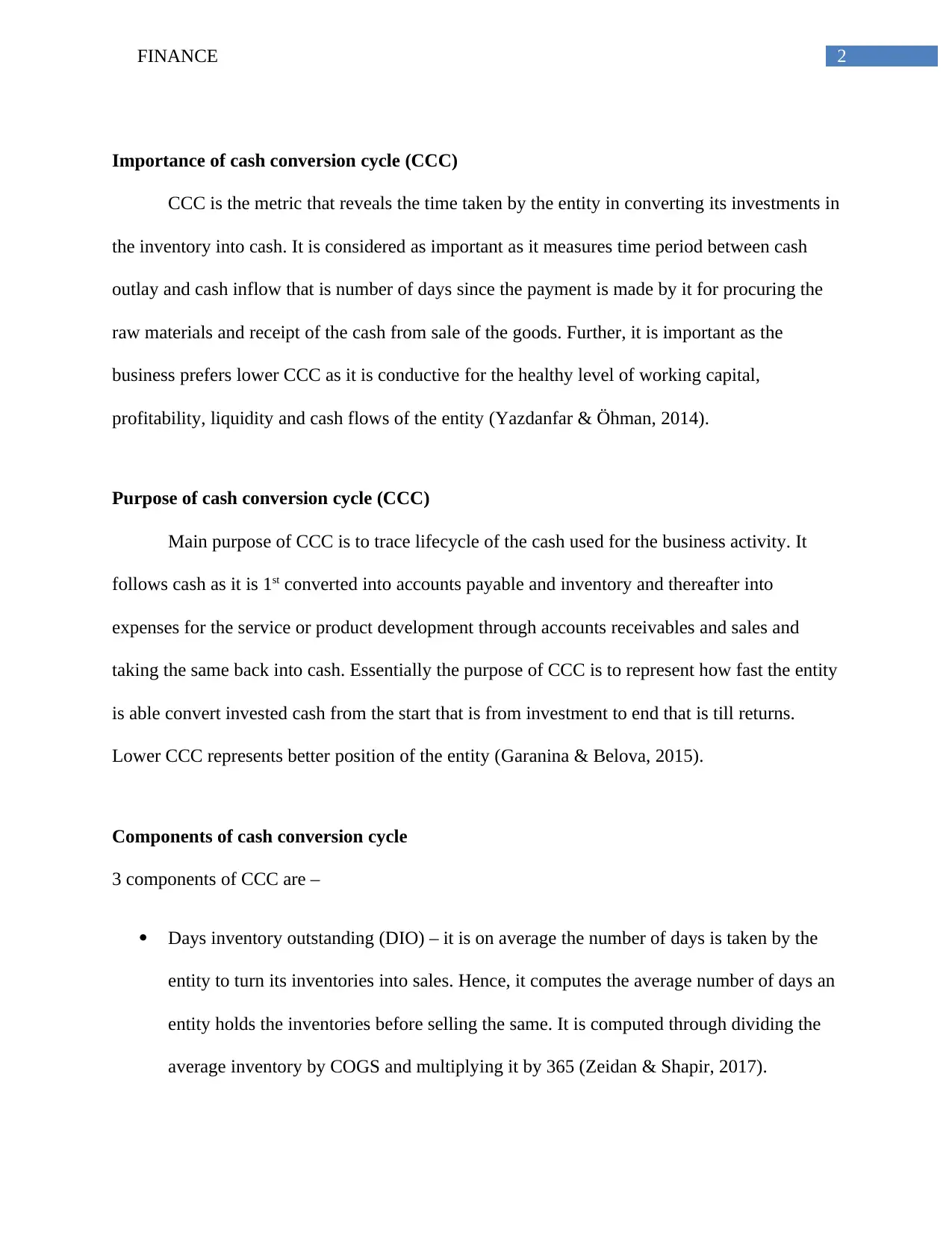
2FINANCE
Importance of cash conversion cycle (CCC)
CCC is the metric that reveals the time taken by the entity in converting its investments in
the inventory into cash. It is considered as important as it measures time period between cash
outlay and cash inflow that is number of days since the payment is made by it for procuring the
raw materials and receipt of the cash from sale of the goods. Further, it is important as the
business prefers lower CCC as it is conductive for the healthy level of working capital,
profitability, liquidity and cash flows of the entity (Yazdanfar & Öhman, 2014).
Purpose of cash conversion cycle (CCC)
Main purpose of CCC is to trace lifecycle of the cash used for the business activity. It
follows cash as it is 1st converted into accounts payable and inventory and thereafter into
expenses for the service or product development through accounts receivables and sales and
taking the same back into cash. Essentially the purpose of CCC is to represent how fast the entity
is able convert invested cash from the start that is from investment to end that is till returns.
Lower CCC represents better position of the entity (Garanina & Belova, 2015).
Components of cash conversion cycle
3 components of CCC are –
Days inventory outstanding (DIO) – it is on average the number of days is taken by the
entity to turn its inventories into sales. Hence, it computes the average number of days an
entity holds the inventories before selling the same. It is computed through dividing the
average inventory by COGS and multiplying it by 365 (Zeidan & Shapir, 2017).
Importance of cash conversion cycle (CCC)
CCC is the metric that reveals the time taken by the entity in converting its investments in
the inventory into cash. It is considered as important as it measures time period between cash
outlay and cash inflow that is number of days since the payment is made by it for procuring the
raw materials and receipt of the cash from sale of the goods. Further, it is important as the
business prefers lower CCC as it is conductive for the healthy level of working capital,
profitability, liquidity and cash flows of the entity (Yazdanfar & Öhman, 2014).
Purpose of cash conversion cycle (CCC)
Main purpose of CCC is to trace lifecycle of the cash used for the business activity. It
follows cash as it is 1st converted into accounts payable and inventory and thereafter into
expenses for the service or product development through accounts receivables and sales and
taking the same back into cash. Essentially the purpose of CCC is to represent how fast the entity
is able convert invested cash from the start that is from investment to end that is till returns.
Lower CCC represents better position of the entity (Garanina & Belova, 2015).
Components of cash conversion cycle
3 components of CCC are –
Days inventory outstanding (DIO) – it is on average the number of days is taken by the
entity to turn its inventories into sales. Hence, it computes the average number of days an
entity holds the inventories before selling the same. It is computed through dividing the
average inventory by COGS and multiplying it by 365 (Zeidan & Shapir, 2017).
⊘ This is a preview!⊘
Do you want full access?
Subscribe today to unlock all pages.

Trusted by 1+ million students worldwide
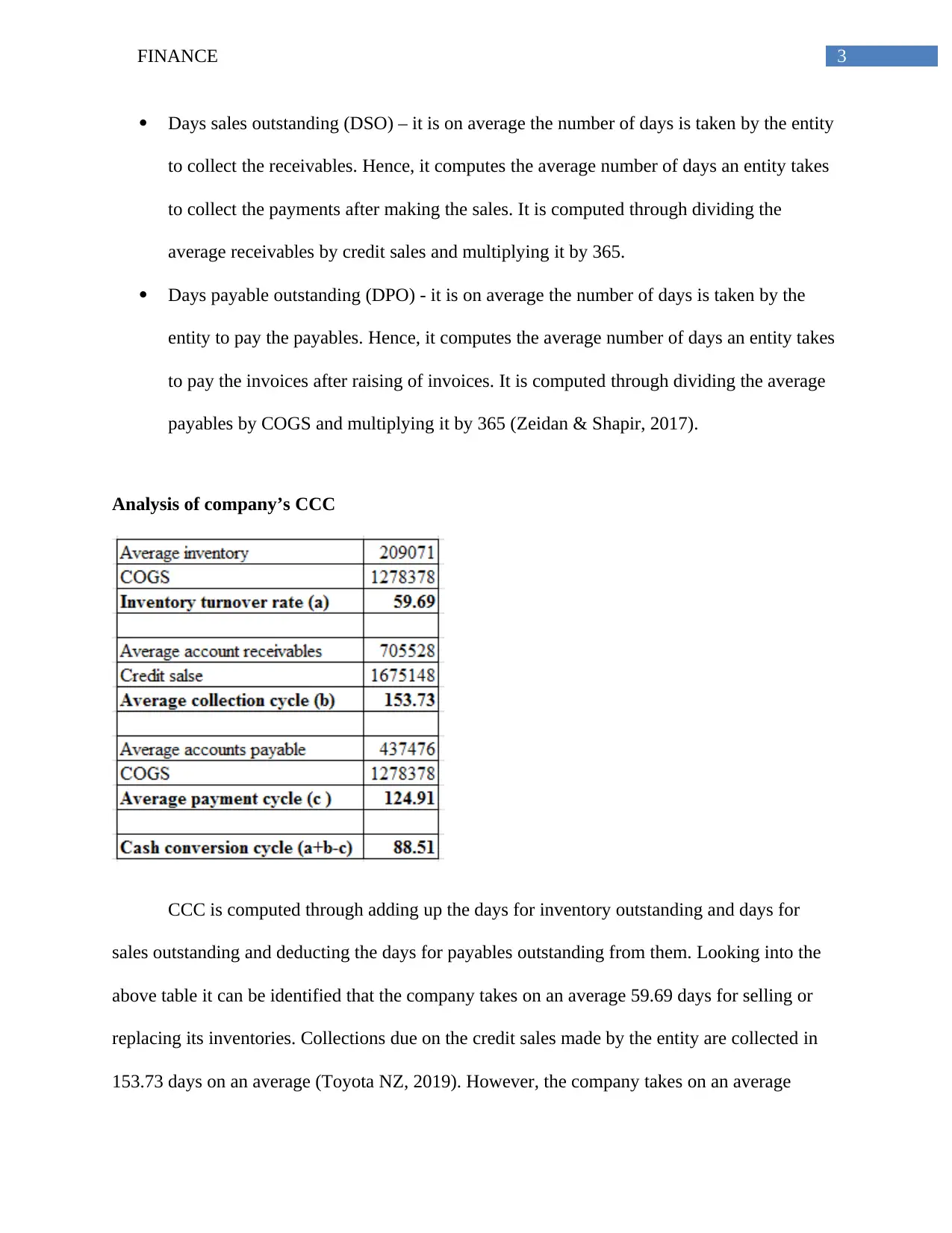
3FINANCE
Days sales outstanding (DSO) – it is on average the number of days is taken by the entity
to collect the receivables. Hence, it computes the average number of days an entity takes
to collect the payments after making the sales. It is computed through dividing the
average receivables by credit sales and multiplying it by 365.
Days payable outstanding (DPO) - it is on average the number of days is taken by the
entity to pay the payables. Hence, it computes the average number of days an entity takes
to pay the invoices after raising of invoices. It is computed through dividing the average
payables by COGS and multiplying it by 365 (Zeidan & Shapir, 2017).
Analysis of company’s CCC
CCC is computed through adding up the days for inventory outstanding and days for
sales outstanding and deducting the days for payables outstanding from them. Looking into the
above table it can be identified that the company takes on an average 59.69 days for selling or
replacing its inventories. Collections due on the credit sales made by the entity are collected in
153.73 days on an average (Toyota NZ, 2019). However, the company takes on an average
Days sales outstanding (DSO) – it is on average the number of days is taken by the entity
to collect the receivables. Hence, it computes the average number of days an entity takes
to collect the payments after making the sales. It is computed through dividing the
average receivables by credit sales and multiplying it by 365.
Days payable outstanding (DPO) - it is on average the number of days is taken by the
entity to pay the payables. Hence, it computes the average number of days an entity takes
to pay the invoices after raising of invoices. It is computed through dividing the average
payables by COGS and multiplying it by 365 (Zeidan & Shapir, 2017).
Analysis of company’s CCC
CCC is computed through adding up the days for inventory outstanding and days for
sales outstanding and deducting the days for payables outstanding from them. Looking into the
above table it can be identified that the company takes on an average 59.69 days for selling or
replacing its inventories. Collections due on the credit sales made by the entity are collected in
153.73 days on an average (Toyota NZ, 2019). However, the company takes on an average
Paraphrase This Document
Need a fresh take? Get an instant paraphrase of this document with our AI Paraphraser
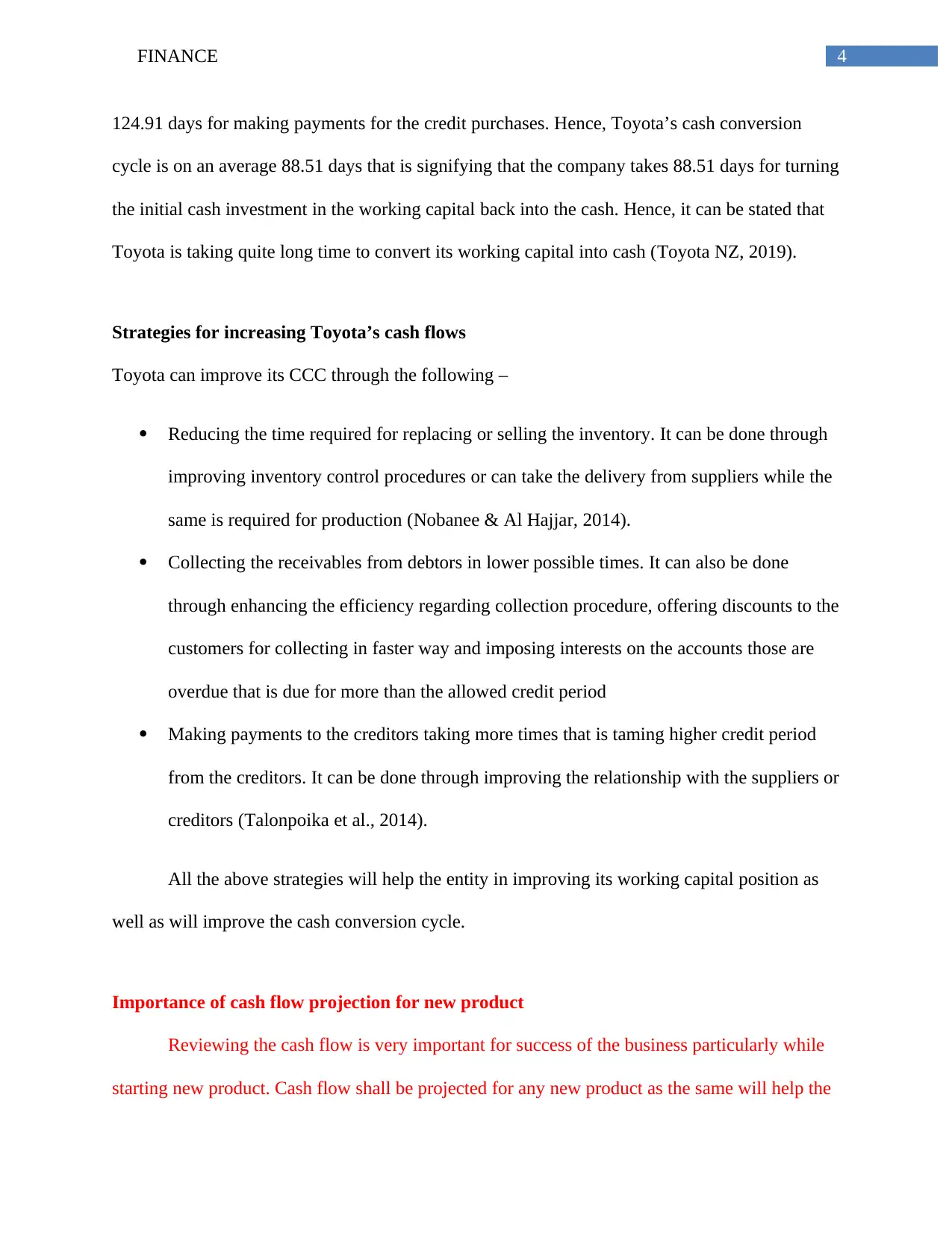
4FINANCE
124.91 days for making payments for the credit purchases. Hence, Toyota’s cash conversion
cycle is on an average 88.51 days that is signifying that the company takes 88.51 days for turning
the initial cash investment in the working capital back into the cash. Hence, it can be stated that
Toyota is taking quite long time to convert its working capital into cash (Toyota NZ, 2019).
Strategies for increasing Toyota’s cash flows
Toyota can improve its CCC through the following –
Reducing the time required for replacing or selling the inventory. It can be done through
improving inventory control procedures or can take the delivery from suppliers while the
same is required for production (Nobanee & Al Hajjar, 2014).
Collecting the receivables from debtors in lower possible times. It can also be done
through enhancing the efficiency regarding collection procedure, offering discounts to the
customers for collecting in faster way and imposing interests on the accounts those are
overdue that is due for more than the allowed credit period
Making payments to the creditors taking more times that is taming higher credit period
from the creditors. It can be done through improving the relationship with the suppliers or
creditors (Talonpoika et al., 2014).
All the above strategies will help the entity in improving its working capital position as
well as will improve the cash conversion cycle.
Importance of cash flow projection for new product
Reviewing the cash flow is very important for success of the business particularly while
starting new product. Cash flow shall be projected for any new product as the same will help the
124.91 days for making payments for the credit purchases. Hence, Toyota’s cash conversion
cycle is on an average 88.51 days that is signifying that the company takes 88.51 days for turning
the initial cash investment in the working capital back into the cash. Hence, it can be stated that
Toyota is taking quite long time to convert its working capital into cash (Toyota NZ, 2019).
Strategies for increasing Toyota’s cash flows
Toyota can improve its CCC through the following –
Reducing the time required for replacing or selling the inventory. It can be done through
improving inventory control procedures or can take the delivery from suppliers while the
same is required for production (Nobanee & Al Hajjar, 2014).
Collecting the receivables from debtors in lower possible times. It can also be done
through enhancing the efficiency regarding collection procedure, offering discounts to the
customers for collecting in faster way and imposing interests on the accounts those are
overdue that is due for more than the allowed credit period
Making payments to the creditors taking more times that is taming higher credit period
from the creditors. It can be done through improving the relationship with the suppliers or
creditors (Talonpoika et al., 2014).
All the above strategies will help the entity in improving its working capital position as
well as will improve the cash conversion cycle.
Importance of cash flow projection for new product
Reviewing the cash flow is very important for success of the business particularly while
starting new product. Cash flow shall be projected for any new product as the same will help the
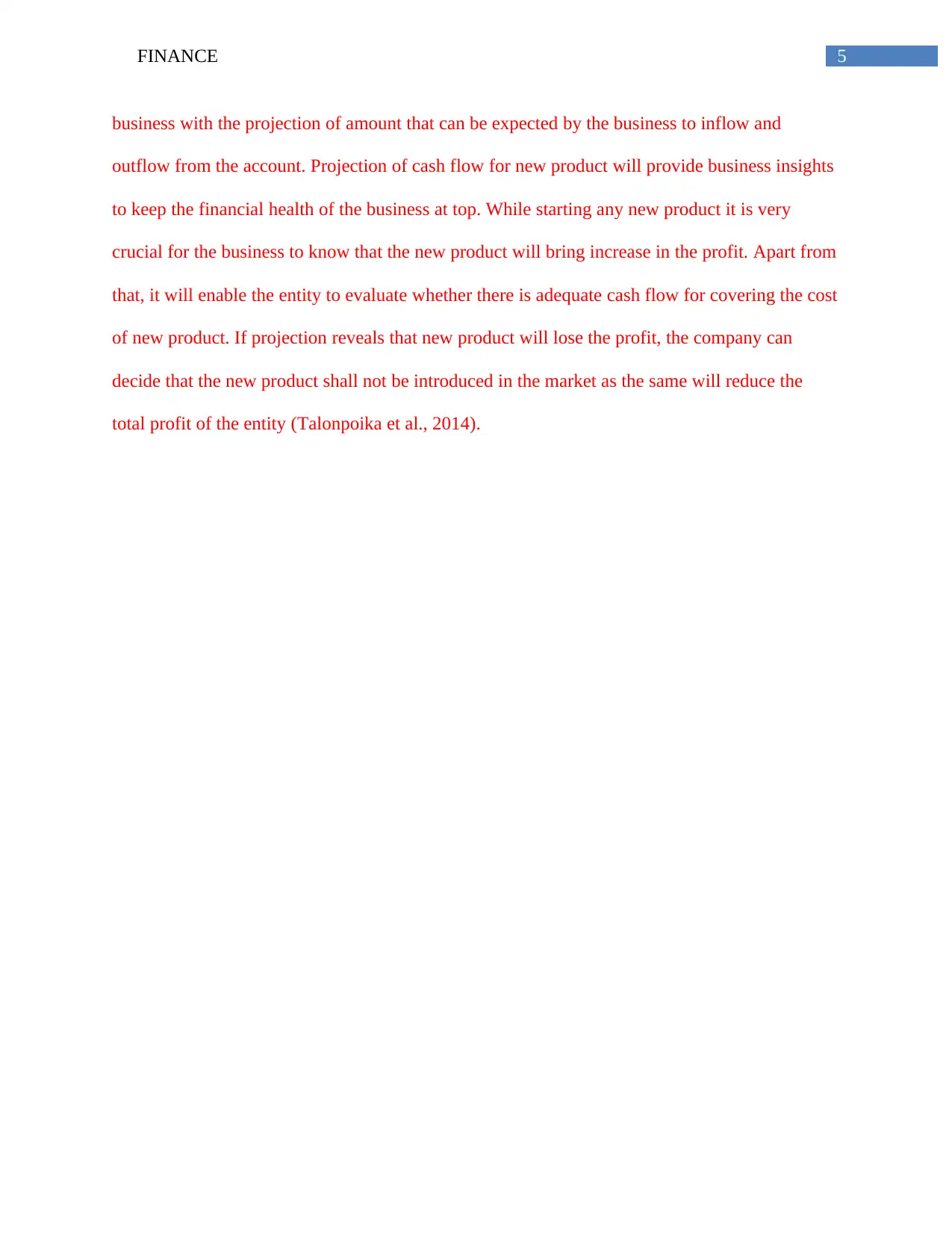
5FINANCE
business with the projection of amount that can be expected by the business to inflow and
outflow from the account. Projection of cash flow for new product will provide business insights
to keep the financial health of the business at top. While starting any new product it is very
crucial for the business to know that the new product will bring increase in the profit. Apart from
that, it will enable the entity to evaluate whether there is adequate cash flow for covering the cost
of new product. If projection reveals that new product will lose the profit, the company can
decide that the new product shall not be introduced in the market as the same will reduce the
total profit of the entity (Talonpoika et al., 2014).
business with the projection of amount that can be expected by the business to inflow and
outflow from the account. Projection of cash flow for new product will provide business insights
to keep the financial health of the business at top. While starting any new product it is very
crucial for the business to know that the new product will bring increase in the profit. Apart from
that, it will enable the entity to evaluate whether there is adequate cash flow for covering the cost
of new product. If projection reveals that new product will lose the profit, the company can
decide that the new product shall not be introduced in the market as the same will reduce the
total profit of the entity (Talonpoika et al., 2014).
⊘ This is a preview!⊘
Do you want full access?
Subscribe today to unlock all pages.

Trusted by 1+ million students worldwide
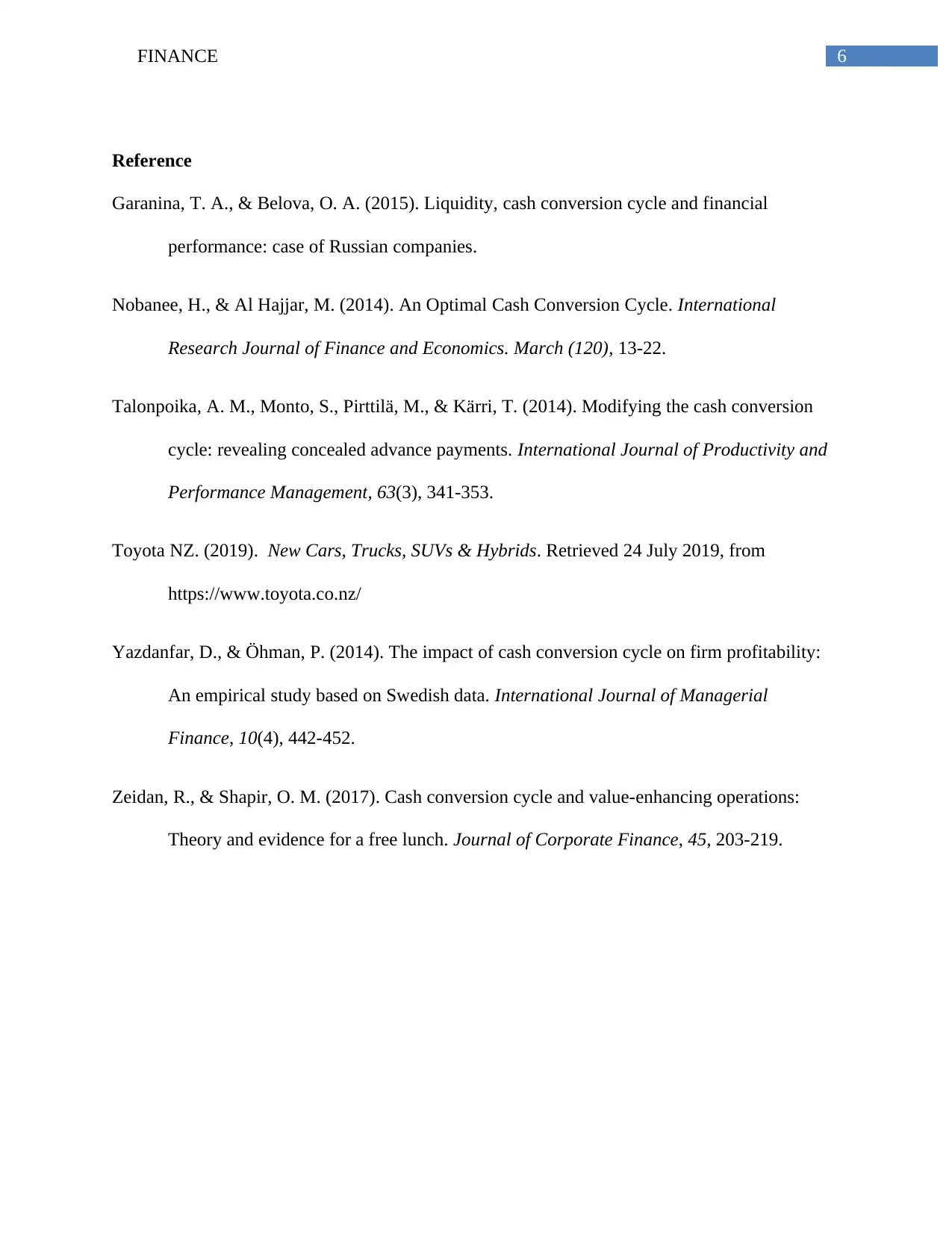
6FINANCE
Reference
Garanina, T. A., & Belova, O. A. (2015). Liquidity, cash conversion cycle and financial
performance: case of Russian companies.
Nobanee, H., & Al Hajjar, M. (2014). An Optimal Cash Conversion Cycle. International
Research Journal of Finance and Economics. March (120), 13-22.
Talonpoika, A. M., Monto, S., Pirttilä, M., & Kärri, T. (2014). Modifying the cash conversion
cycle: revealing concealed advance payments. International Journal of Productivity and
Performance Management, 63(3), 341-353.
Toyota NZ. (2019). New Cars, Trucks, SUVs & Hybrids. Retrieved 24 July 2019, from
https://www.toyota.co.nz/
Yazdanfar, D., & Öhman, P. (2014). The impact of cash conversion cycle on firm profitability:
An empirical study based on Swedish data. International Journal of Managerial
Finance, 10(4), 442-452.
Zeidan, R., & Shapir, O. M. (2017). Cash conversion cycle and value-enhancing operations:
Theory and evidence for a free lunch. Journal of Corporate Finance, 45, 203-219.
Reference
Garanina, T. A., & Belova, O. A. (2015). Liquidity, cash conversion cycle and financial
performance: case of Russian companies.
Nobanee, H., & Al Hajjar, M. (2014). An Optimal Cash Conversion Cycle. International
Research Journal of Finance and Economics. March (120), 13-22.
Talonpoika, A. M., Monto, S., Pirttilä, M., & Kärri, T. (2014). Modifying the cash conversion
cycle: revealing concealed advance payments. International Journal of Productivity and
Performance Management, 63(3), 341-353.
Toyota NZ. (2019). New Cars, Trucks, SUVs & Hybrids. Retrieved 24 July 2019, from
https://www.toyota.co.nz/
Yazdanfar, D., & Öhman, P. (2014). The impact of cash conversion cycle on firm profitability:
An empirical study based on Swedish data. International Journal of Managerial
Finance, 10(4), 442-452.
Zeidan, R., & Shapir, O. M. (2017). Cash conversion cycle and value-enhancing operations:
Theory and evidence for a free lunch. Journal of Corporate Finance, 45, 203-219.
1 out of 7
Related Documents
Your All-in-One AI-Powered Toolkit for Academic Success.
+13062052269
info@desklib.com
Available 24*7 on WhatsApp / Email
![[object Object]](/_next/static/media/star-bottom.7253800d.svg)
Unlock your academic potential
Copyright © 2020–2025 A2Z Services. All Rights Reserved. Developed and managed by ZUCOL.




